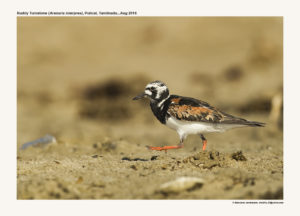
Ruddy Turnstone Arenaria interpres
Etymology:
- Arenaria: Latin word “relating to sand”
- Interpres: Latin word for “ Messenger”
Vernacular Names: Guj: Kachabarangi, Ta: Kal purratti, Mal: Tirakkata, Sinh: Oleyiya, Mald: Ratafy, Hindi: Patthar Palta, Mar: Mutara, Rangit tutari
Distribution in India: Widespread Winter visitor in Coastal India.
Description: Size of 21–26 cm; wt. of 84–190 g; wingspan of 50–57 cm. It is a robust shorebird with short legs; black-and-white head, throat, neck and breast; upperparts rufous-chestnut with black-brown patches; underparts white; distinctive pattern in flight, with white back, rump, uppertail-coverts, wingbar and patch on inner wing contrasting with otherwise dark upperparts. The female has more extensive streaking on crown; brownish nape; somewhat duller upperparts; some pale flecking on breast patch. The non-breeding adult is much duller, with upperparts dark greyish brown and blackish; head mostly dark grey-brown; black areas of neck and breast replaced with dark grey-brown. The Juvenile like adult non-breeding, but browner above with buff fringes and paler on head.
Habitat:It is found in Stony coastal plains, marshy slopes and flats in lowlands, and tundra. After breeding found occurs inland only on migration, on short-grass salt-marshes and along dykes; rocky, shingly, and stony shores and breakwaters, sandy beaches with washed-up seaweed, sheltered inlets, estuaries, mangrove stands, exposed reefs and mudflats.
Food Habits: It eats small fish, crustaceans, molluscs and many insects; sometimes plant matter like seeds. It flips over objects such as stones, shells and seaweed with quick jerking movements, and may work together to overturn larger objects, while rolls up mats of seaweed by moving swiftly forwards pushing bill and forehead below the vegetation; prey underneath is pecked at or chased; sometimes pushes larger object with breast; frequently scavenges on carrion such as dead fish.
Breeding Habits: They breeds in May-July in western Alaska, Ellesmere Island, Greenland, Norway, Denmark, Sweden, Finland, Estonia ,Scotland, Germany and northern Russia. The nest is placed in wet or dry hummocky sites; may be concealed in or under vegetation, occasionally within rock fissure, or in fully open sites, generally preferring sloped or terraced ground. The nest is a slight depression lined with various amounts of plant material and constructed by female alone. They lay a clutch of 4 eggs. The incubation period is 22-24 days. Incubation is done by both sexes, mainly by female from last egg. The chicks are cared for by both sexes for 1–2 weeks, where after female leaves the chicks to the male. The fledging period is 19–26 days.